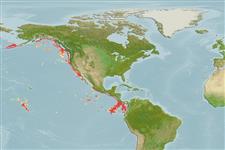Teleostei (teleosts) >
Perciformes/Zoarcoidei (Eelpouts and pricklebacks) >
Zoarcidae (Eelpouts) > Lycodinae
Etymology: Lycenchelys: Greek, lykos = wolf + Greek, enchelys, -yos = eel (Ref. 45335); jordani: Named after David Starr Jordan, eminent U.S. ichthyologist (Ref. 6885).
More on authors: Evermann & Goldsborough.
Environment: milieu / climate zone / depth range / distribution range
Ecology
Marine; bathydemersal; depth range 1686 - 2200 m (Ref. 6885). Deep-water
Eastern Pacific: Alaska to California, USA.
Size / Weight / Age
Maturity: Lm ? range ? - ? cm
Max length : 33.0 cm SL male/unsexed; (Ref. 11954)
Short description
Identification keys | Morphology | Morphometrics
Dorsal spines (total): 0; Dorsal soft rays (total): 116; Anal spines: 0; Anal soft rays: 93. Caudal not readily distinguishable from dorsal and anal fins; pectorals broad and rounded; pelvic fins very small (Ref. 6885). Brownish olive; scales are light in color giving the body a finely spotted appearance; head, pectorals, and edges of upright fins darker olive (Ref. 6885).
Life cycle and mating behavior
Maturities | Reproduction | Spawnings | Egg(s) | Fecundities | Larvae
Anderson, M.E., 1994. Systematics and osteology of the Zoarcidae (Teleostei: Perciformes). Ichthyol. Bull. J.L.B. Smith Inst. Ichthyol. 60:120 p. (Ref. 11954)
IUCN Red List Status (Ref. 130435)
Threat to humans
Harmless
Human uses
Tools
Special reports
Download XML
Internet sources
Estimates based on models
Preferred temperature (Ref.
123201): 2.1 - 2.6, mean 2.5 °C (based on 38 cells).
Phylogenetic diversity index (Ref.
82804): PD
50 = 0.5000 [Uniqueness, from 0.5 = low to 2.0 = high].
Bayesian length-weight: a=0.00120 (0.00057 - 0.00252), b=3.10 (2.91 - 3.29), in cm total length, based on LWR estimates for this (Sub)family-body shape (Ref.
93245).
Trophic level (Ref.
69278): 3.4 ±0.5 se; based on size and trophs of closest relatives
Resilience (Ref.
120179): Low, minimum population doubling time 4.5 - 14 years (Preliminary K or Fecundity.).
Fishing Vulnerability (Ref.
59153): Low to moderate vulnerability (30 of 100).
